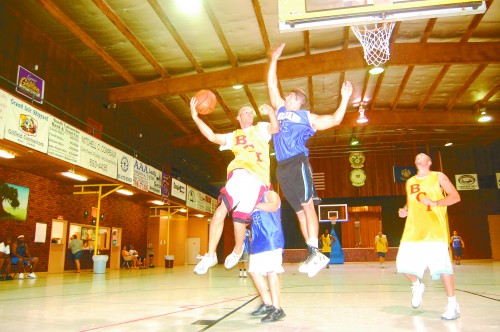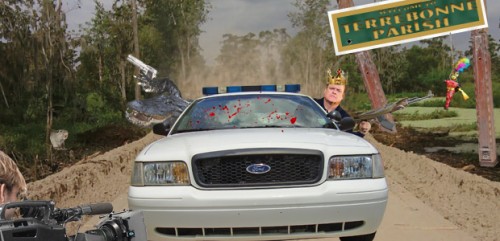
Terrebonne hosting fundraising tournament
May 29, 2012
Cecile Brou Mongrue
May 31, 2012The Bayou has once again lured the national spotlight upon itself and seems eager to continue revealing its eccentrics, this time as they navigate a gravitating backdrop of crime.
“Cajun Justice,” formerly “Cajun Blue,” and always colloquially referred to as the reality cop show ushered in by Terrebonne Sheriff Vernon Bourgeois that will likely discontinue filming once incoming-Sheriff Jerry Larpenter reprises his role, premieres at 9 p.m., June 7 on A&E. The cable network has green-lit 21 half-hour episodes.
“We are thrilled to introduce visitors to this fascinating, strange and dangerous world they have never seen before,” says David McKillop, executive vice president of programming for A&E, in a press release. Say, what?
Cable networks and television producers have set up shop in Louisiana for “unscripted television,” no doubt influenced by the state tax incentives offered to producers who can create a show worth dumping capital into.
A&E, whose tagline is “Real Life. Drama,” already has hits in Louisiana-centric “Duck Dynasty” and “Billy the Exterminator.” CMT has “Bayou Billionaires” and “My Big Redneck Vacation.” History features “Swamp People” and “Cajun Pawn Stars.” There’s also Discovery’s “Ragin Cajuns” and “Sons of Guns,” plus more.
Based on teasers for several episodes on A&E’s website, “Cajun Justice” follows a well-crafted formula.
A female deputy and her alligator nuisance hunter boyfriend are among those profiled, the deputy’s hometown of Massachusetts serving as a peg for an outsider’s perspective into the area. Another deputy, known for his highlighted hair, is followed into a hair salon in a non-voodoo, light-hearted moment. Discarding subtlety, everyone speaks in blatantly intense fashion. Several episodes deal with themes of mysticism, emanating bewilderment. A skull is allegedly stolen off a corpse, but the deputy refuses to open the casket. A 7-foot hairy beast supposedly appears on the banks of Bayou Little Caillou … and the witness has iPhone video proof. Move over, Sasquatch.
A&E describes the portrayals with a gamut of adjectives in press releases: “unique,” “unusual,” “eerie,” “fiery,” “sticky,” “gruesome,” “fascinating,” “strange,” “dangerous” and “bizarre.”
Still, the repeated exposure of Terrebonne Parish, which can boast dozens of alluring qualities, has intrigued some tourism stakeholders.
“Swamp People,” which features Houma native alligator hunters R.J. and Jay Paul Molinere, has been a boon for Terrebonne tourism, the stakeholders say. Lazy bayous and drooping Cyprus give the setting life, and broadcasting the scene nationwide is a tourism asset, all seem to agree.
But the bayou’s people, they wild yeah.
The national audience got a taste of what to expect regarding behavior of Terrebonne residents when videos and press releases began to surface. The releases’ consistent lede describes the Terrebonne Parish Sheriff’s Office as a “world where the sheriff is like a king, voodoo is a common practice and no police call is routine.”
The monarch, sometimes referred to as Bourgeois, did not respond to repeated interview requests.
Perhaps the simile is more truthful than A&E’s account of the premise when the show was announced in May 2011, then with the working title “Cajun Blue.”
TPSO, the original release says, patrols that Louisiana swampland while its deputies “investigate thousands of violent crimes every year in the creepy, eerie, bayou.”
The sheriff’s office investigated five homicides, 27 rapes, 301 assaults and 35 robberies in 2010, according to numbers the office filed with the FBI. That does not equal one thousand.
What is ‘Cajun Justice’?
“Tell him he needs Cajun Justice,” an unnamed woman says unenthusiastically to an deputy during a dispute. “Bring him here.” The unnamed man standing by her side doesn’t miss a beat: “Y’all come on over here,” he hollers to an unseen group. “Y’all want to run y’all’s mouths? I’m on the bank.”
This sequence is posted on A&E’s website under the title, “Definition of Cajun Justice,” a bonus video. The shot cuts to Cpl. Storm Fitch, who illuminates the “Cajun Justice” premise while a rusted truck rots and a bayou runs in the background. A shotgun is used as B-roll.
“And instead of calling us, they’ll try to take the law into their own hands, and most of the time it will end up into a gun fight,” Fitch says.
Sure enough, a gun was fired, the woman tells a deputy with a camera perched above his shoulder. “He said, ‘Shut up you fat b—-, I’ve got something for you,’ and he pulled out a gun and shot it at me.”
The video goes on to show other dramatic examples, with grown men shouting and waving their arms, one brandishing a wooden weapon before dropping it to remove his muscle shirt. Innocent residents and deputies alike face interviewers and give supporting testimony about Cajun Justice, a technique showrunners describe as the Cajun Chorus.
Mark Kadin, executive producer with MAK Pictures, was introduced to Terrebonne by another of the show’s executive producers, former Los Angeles Police Department officer Ken Reichling. Kadin and Reichling met while Kadin was producing “America’s Most Wanted: America Fights Back.”
Reichling had transported a fugitive to Terrebonne a decade ago and “fell in love with the place,” Kadin says. Now out of the law enforcement business, Reichling approached Kadin with the “Cajun Justice” idea about 18 months ago and set the foundation for the show, according to Kadin.
Filmmakers started work in September 2011, Kadin says, and will wrap at the end of this month. The cable network first announced speculative plans in April 2011.
Kadin has a noble, artistic view of the show’s goal, saying it teeters on the realm of sitcom. He insists there are no paid actors, although a tease for the show carries a contrary disclaimer.
“Even though it’s ‘Cajun Justice,’ I would almost characterize it as a character show over a law enforcement show,” Kadin says. “We’re really exploring the people and what makes up Cajun culture.
“It’s very visual. I think it’s more visual than most shows, like even more than ‘Swamp People,’ anything else that’s down there. We really try to make the bayou itself a character. There’s lots of talk about the bayous, the shrimping community and the people that work on the water.”
Kadin says the show conforms to a three-act structure with two commerical breaks. Some episodes have themes, such as “Full Moon Madness,” the eighth episode of the season. Kadin tries to compile each episode with one light-action story, a second with a mysticism angle and a third geared toward humor, he says. In addition to regular car patrols, the show frequently takes to the department’s boats to cruise parish bayous.
“Every case that we use (in the show), we try to have some sort of interesting thing about the case that makes it southern Louisiana, that makes it a Cajun case,” Kadin says. “There’s so many cases in the city there that are like any other cop show that you’ve seen. Basically, 90 percent of the stuff that we even shoot with the guys, we will never use because it just doesn’t fit what we’re trying to do with the show.”
Draw or deterrent?
Although the executive producer claims the show is a character-driven examination of deputies, non-criminalized local people and regional nature, each glimpse of the show released by A&E carries ominous, and quite possibly insulting, undertones about the area and its inhabitants.
Cpl. Fitch, in a 22-second promotional video, sums up local criminals. Fitch delivers his message while leaning against a deputy’s car. As he speaks, a gun fires and images of the bayous, a profile of a man in a shipyard and distorted trees flash on the screen.
“What’s really different about being a cop in Cajun Country is that the people, the individuals we deal with out here are a lot tougher than any of the individuals that you’ll ever deal with anywhere else in the country,” Fitch says. “These people have a lot of weapons, and they really know how to use them. They can take down a human with no problem.”
Kadin says the video – as well as another inflammatory, 5-minute “sizzle reel” that has since been pulled offline – was not made to sell the show to the public, but to A&E as a structure prototype. Among other items, the 5-minute clip demonstrated the investigation that eventually led to the 2006 arrest of convicted serial killer Ronald Dominique.
“That’s our sales tool that we have to use to sell the show to the network,” Kadin says. “But the serial killer case was from two years ago, or before that, right? That was never something that was going to be part of the show. Then, the thing about, ‘Everyone’s got guns and they know how to use them.’ That stuff is a little sensationalized for a teaser when you’re trying to sell a show to a network, but that doesn’t necessarily mean that that’s what the show is going to be about. That’s why you’ll never really see a teaser and it wasn’t supposed to be for public consumption, because I think it gave people the wrong idea of what the show was going to be about.”
But A&E’s press releases, which have been edited over time, maintain a theme similar to the videos in introducing the show to its national audience.
“With the fiery personalities of the local Cajuns and the Louisiana justice system unlike any other (It’s the only state that is ruled under Napoleonic law), there’s no such thing as an ordinary police call,” the press release reads. “Whether it’s a creepy sighting of the Rougarou (“shape-shifting swamp monster”), a distressed neighbor reporting a stolen air condition during a heat wave, or a lead on a gruesome local serial-killer case; the deeper into the sticky swampland the deputies dive, the stranger and more mysterious the calls become.
“In the remote swamps, certain residents think the rules don’t apply to them and are more than willing to fight back. As the heat and humidity rises, so does the crime rate and unusual behavior (sic).”
Terrebonne Parish President Michel Claudet has seen two episodes. Both were entertaining and neither shamed the parish “in any way,” he says. Claudet says he remains hopeful the show will help parish tourism, but adds that his sample size is not large enough for him to take a macro stance on the program.
“If there are other episodes that would portray Terrebonne Parish in a poor light, then certainly it would cause me concern,” Claudet says. “I’m just like the rest of the people in the parish; I haven’t seen it yet.”
Sharon Alford, executive director of the Houma Convention and Visitor’s Bureau, says she is unfamiliar the show’s promotional materials and has not seen an episode, therefore she’s unable to comment on how “Cajun Justice” may impact tourism.
History’s “Swamp People” has helped tourism because visitors are lured to the “beautiful environment” the show portrays and find it endearing that people make a living off the land, Alford says.
When posed with some of the adjectives A&E has used to explain the show, Alford deflected and brought up a separate issue in which an ESPN personality last month criticized New Orleans for being too dangerous a place to host national sporting events.
“Do you have a potential for people to believe those comments? I think maybe, years ago, there was a bigger potential for that,” Alford says. “I think today, you have so many opportunities on the Internet and social media that people who have travelled and have had no problem have the opportunity to go online and comment and counter what is being said on it … I think there are many mediums now that people can use to tell the truth.”
Larpenter, who was Terrebonne’s sheriff for 20 years before making a bid for the parish presidency in 2008, won re-election last year and returns to office July 1. As the sheriff-elect, Larpenter also watched two “Cajun Justice” episodes. He says the content is fictionalized and defiantely adds the department will not allow filming to continue when he takes office, in part because of the way the parish is represented.
“They’re taking our beautiful fishing area, and, to me, they’re scaring people,” Larpenter says. “Why do you want to come down here and fish when you might get shot?”
Peristant exposure, coupled with crisp geographical shots, is why, Kadin says.
“It could definitely bring tourism to the area, especially since Terrebonne is such a big part of the show itself,” Kadin says. “It’s mentioned over 20 times each episode.”
21 and done
“It’s over with when I get in office,” Larpenter says. “I’m sorry, but I’m not into reality shows. My stance is simple. … I want police officers. I don’t want actors.”
The incoming sheriff says the $1,500 the department receives per aired episode doesn’t cover the expenses of using the department’s resources for filming, and he says profiling a select group of deputies may cause a “morale problem.” Larpenter also accused producers of exploiting the sheriff’s department and Cajun people for the sake of high ratings and the potential for millions of dollars in advertising revenue.
Kadin continues to hope Larpenter will change his mind when he sees the tourism benefits. “There is a proposal out to him,” he says.
For now, locals and nationals alike can bask in the condensed characterization of alleged Terrebonne residents and share this concentrated introduction into the ways the silent minority lives.
A&E is “thrilled to introduce visitors to this fascinating, strange and dangerous world they have never seen before,” according to the network’s executive vice president of programming.
Terrebonne Parish Sheriff Vernon Bourgeois and a band of his deputies grace the A&E network this month for the premiere of “Cajun Justice,” a reality cop show that highlights Cajun culture and mannerisms.
“Deputy Keith Bergeron is called in to deal with a possible grave robbery. Voodoo rarely makes itself obvious, but its mysterious presence can be felt everywhere,” reads the caption posted on www.aetv.com.
“Sergeant Merlin Daigre, a veteran of the United States Marine Corps, cuts an imposing figure on the streets of Terrebonne Parish,” reads the caption posted on www.aetv.com.













